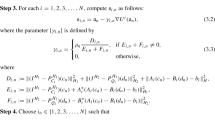Abstract
An exact Newton method for solving a nonlinear complementarity problem consists of solving a sequence of linear complementarity subproblems. For problems of large size, solving the subproblems exactly can be very expensive. In this paper we study inexact Newton methods for solving the nonlinear, complementarity problem. In such an inexact method, the subproblems are solved only up to a certain degree of accuracy. The necessary accuracies that are needed to preserve the nice features of the exact Newton method are established and analyzed. We also discuss some extensions as well as an application.
Similar content being viewed by others
References
H.Z. Aashtiani, “The multi-modal traffic assignment problem,” Ph.D. dissertation, Alfred P. Sloan School of Management, Massachusetts Institute of Technology (1979).
R.W. Cottle, S.G. Duval and K. Zikan, “A Lagrangean relaxation algorithm for the constrained matrix problem,”Naval Research Logistics Quarterly 33 (1986) 55–76
R.S. Dembo, S.G. Eisenstat and T. Steihaug, “Inexact Newton methods,”SIAM Journal on Numerical Analysis 19 (1982) 400–408.
R.S. Dembo and U. Tulowitzki, “Sequential truncated quadratic programming methods,” in Paul T. Boggs, R.H. Byrd and R.B. Schnabel, eds.,Numericla Optimization 1984 (SIAM, Philadelphia, 1985) pp. 83–101.
R.S. Dembo and U. Tulowitzki “Local convergence analysis for successive inexact quadratic programming methods,” SOM Working Paper, Series B #78, School of Organization and Management, Yale University (Revised October 1984).
J.E. Dennis and J. Moré, “Quasi-Newton methods: Motivation and theory,”SIAM Review 19 (1977) 46–89.
B.C. Eaves, “Where solving for stationary points by LCPs is mixing Newton iterates,” in B.C. Eaves, F.J. Gould, H.O. Peitgen and M.J. Todd, eds.Homotopy Methods and Global Convergence (Plenum Press, New York, 1983) pp. 63–78.
P.C. Jones, R. Saigal and M. Schneider, “Computing nonlinear network equilibria,”Mathematical Programming 31 (1985) 57–66.
N.H. Josephy, “Newton’s method for generalized equations,” Technical Summary Report No. 1965, Mathematics Research Center, University of Wisconsin (Madison, Wisconsin, 1979).
N.H. Josephy, “Quasi-Newton methods for generalized equations,” Technical Summary Report No. 1966, Mathematics Research Center, University of Wisconsin (Madison, Wisconsin, 1979).
N.H. Josephy, “A Newton method for the PIES energy model,” Technical Summary Report No. 1977, Mathematics Research Center, University of Wisconsin (Madison, Wisconsin, 1979).
L. Mathiesen, “Computational experience in solving equilibrium models by a sequence of linear complementarity problems,”Operations Research 33 (1985) 1225–1250.
J. Ortega and W.C. Rheinboldt,Iterative Solution of Nonlinear Equations in Several Variables (Academic Press, New York, 1970).
J.S. Pang, “Solution of the general multicommodity spatial equilibrium problems by variational and complementarity methods,”Journal of Regional Science 24 (1984) 403–414.
J.S. Pang, “More results on the convergence of iterative methods for the symmetric linear complementarity problem,” to appear inJournal of Optimization Theory and Applications.
J.S. Pang and D. Chan, “Iterative methods for variational and complementarity problems,”Mathematical Programming 24 (1982) 284–313.
J.S. Pang and C.S. Yu, “Linearized simplicial decomposition methods for computing traffic equilibria on networks,”Networks 14 (1984) 427–438.
P.V. Preckel, “Alternative algorithms for computing economic equilibria,” manuscript, Department of Agricultural Economics, Purdue University (West Lafayette, Indiana, 1984).
S.M. Robinson, “Perturbed Kuhn-Tucker points and rates of convergence for a class of nonlinear programming algorithms,”Mathematical Programming 7 (1974) 1–16.
S.M. Robinson, “An implicit-function theorem for generalized variational inequalities,” Technical Summary Report No. 1672, Mathematics Research Center, University of Wisconsin (Madison, Wisconsin, 1976).
S.M. Robinson, “Strongly regular generalized equations,”Mathematics of Operations Research 5 (1980) 43–62.
S.M. Robinson, “Generalized equations,” in A. Bachem, M. Grotschel and B. Korte, eds.,Mathematical Programming: The State of the Art (Springer-Verlag, Berlin, 1983) pp. 346–367.
R.T. Rockafellar, “Monotone operators and the proximal point algorithm,”SIAM Journal on Control and Optimization 14 (1976) 877–898.
U. Tulowitzki, “Inexact successive linearization methods for variational inequality problems,” SOM Working Paper, School of Organization and Management, Yale University (New Haven, Connecticut, October 1984).
Author information
Authors and Affiliations
Additional information
This research was based on work supported by the National Science Foundation under grant ECS-8407240.
Rights and permissions
About this article
Cite this article
Pang, JS. Inexact Newton methods for the nonlinear complementarity problem. Mathematical Programming 36, 54–71 (1986). https://doi.org/10.1007/BF02591989
Received:
Revised:
Issue Date:
DOI: https://doi.org/10.1007/BF02591989




